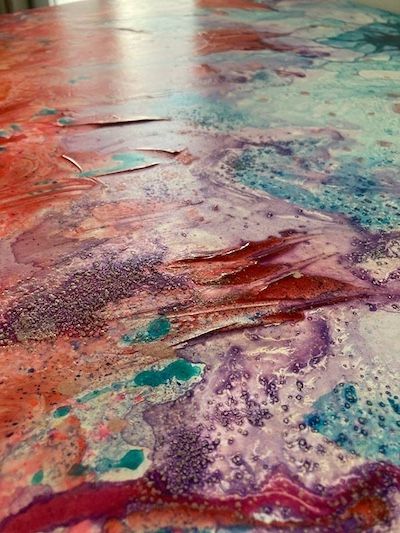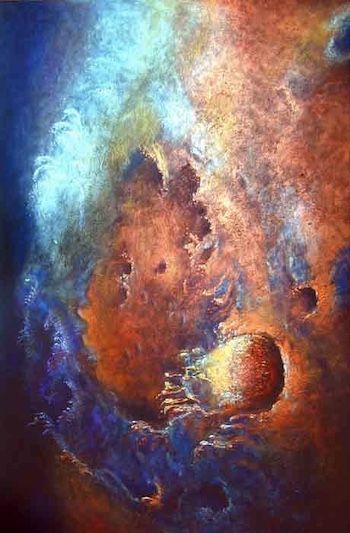Interview with the Artist Behind the Complexity Series
| Q1: What inspired you to create the Complexity series, and what is its central theme? A: The inspiration for this series came from my fascination with the parallels between the vast universe and the microscopic world. I’ve always been drawn to the idea that similar patterns and structures repeat across different scales of existence—whether in swirling galaxies, ocean currents, or cellular formations. The Complexity series is my way of visually exploring these more complex connections, showing how the macro and micro levels of our world mirror each other in intricate and often unexpected ways. Q2: How do you approach the composition of these paintings? Are they planned, or do they evolve organically? A: My process is a balance between structure and spontaneity. While I begin with a loose concept or feeling I want to convey, the painting evolves as I layer marks, textures, and colours. I allow the materials and techniques to guide me, often responding to the way paint marks and flows or how different elements interact. There is an intentionality behind the composition, but there’s also a sense of discovery as I work—just like the way nature continuously builds complexity in its forms. |
 |
Q3: You use a mix of vibrant colours and monochromatic palettes in this series. What influences your choice of colour?
A: Colour plays a significant role in setting the mood and energy of each piece. The vibrant paintings in this series capture the dynamic forces of nature, movement, and transformation, while the monochromatic works focus on structure, depth, and contrast. Sometimes, stripping away colour allows the viewer to focus more on the intricate layering and textures, while other times, rich, harmonios and luminous hues create an immersive, energetic experience. The choice depends on what I want to emphasize in each work—whether it’s the raw movement of energy or the delicate balance of interwoven forms.
Q4: Your work features complex layers of marks and textures. What techniques do you use to create these effects?
A: I use a combination of techniques to build the intricate layers that define this series. Some areas involve fluid, almost ethereal washes that mimic natural flow, while others are created with bold gestural brushstrokes, precise linear details, or scraping techniques to reveal underlying layers. I experiment with transparency, opacity, and texture to create depth, making each painting feel like it exists in multiple dimensions at once. It’s this interplay of different marks and approaches that gives the work its unique, organic quality.
Q5: Do you see your work as purely abstract, or is there a narrative behind these paintings? A: While the Complexity series is viewed as abstract, it carries an underlying narrative of connection between different realms of existence. It’s not about representing a specific scene or subject but about evoking a sense of discovery, curiosity, and reflection. I want viewers to see something familiar yet unknown, prompting them to consider the hidden patterns that link everything around us. Whether they interpret it as cosmic, biological, or something else entirely, the story is open-ended and personal to each observer. A friend of mine, a Dentist, saw one of the precursors in these series, called 'Genesis'. He immediately felt the analogy (of parallel worlds). Because of his background in biology he saw an image of ovulation, where as other viewers saw a planet being thrown off a large sun-like body. Q6: What do you hope viewers take away from experiencing the Complexity series? A: My hope is that these paintings encourage people to see the world with a sense of wonder and interconnectedness. Whether looking up at the stars or down through a microscope, we are surrounded by intricate beauty that often goes unnoticed. If my work inspires someone to reflect on these parallels and appreciate the complexity of nature in a new way, then I’ve achieved what I set out to do with this series. |
 |
Q7: Are there any particular scientific or artistic influences that have shaped this series?
A: Absolutely. I’ve been influenced by scientific imagery—microscopic photography, satellite images of Earth, and astrophotography have all played a role in shaping my visual language. Artistically, I’m drawn to movements like Abstract Expressionism for its energy and fluidity, as well as Surrealism for its exploration of hidden realities. My work is also informed by natural forms, patterns found in physics, and even ancient art that represents cosmic or organic themes.
Q8: What’s next for you? Will you continue exploring these themes in future work?
A: The Complexity series has opened up so many exciting possibilities, and I’m definitely interested in continuing to push these ideas further. I’m currently experimenting with new materials and layering techniques to deepen the textural and dimensional aspects of my work. I’m also considering incorporating more sculptural elements or mixed media approaches to expand the physical presence of these ideas beyond the canvas. The exploration of interconnected worlds—whether universal or microscopic—is something I feel I could investigate endlessly.
I have also long been involved with the studios' dedication to adapting our concepts and ideas to create artworks in the unique and completely different combinations of media for outdoor paintings. This is a creative challenge that inspires us to evolve several visual languages for the same sentiment.
